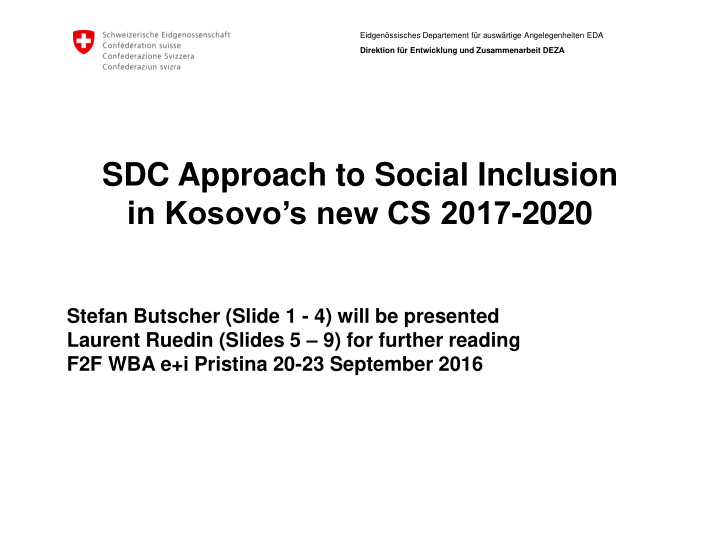



Eidgenössisches Departement für auswärtige Angelegenheiten EDA Direktion für Entwicklung und Zusammenarbeit DEZA SDC Approach to Social Inclusion i n Kosovo’s new CS 2017 -2020 Stefan Butscher (Slide 1 - 4) will be presented Laurent Ruedin (Slides 5 – 9) for further reading F2F WBA e+i Pristina 20-23 September 2016
Eidgenössisches Departement für auswärtige Angelegenheiten EDA Direktion für Entwicklung und Zusammenarbeit DEZA Process for including Social Inclusion into Kosovo’s CS 2017 -2020 1. Include SI in the CS development road map 2. Familiarise with topic and definitions 3. Take stock of what is already done in current CS 4. Conduct external analysis of poverty and conclusion 5. Engage implementing partners in discussion 6. Check with government line agencies and relevant policies 7. Conduct a donor/project mapping of SI relevant projects 8. Adapt on-going projects to SI agenda 9. Develop CS and monitoring framework considering SI
Eidgenössisches Departement für auswärtige Angelegenheiten EDA Direktion für Entwicklung und Zusammenarbeit DEZA Implication for Kosovo’s CS 2017 -2020 • More systematic analysis of social protection in Kosovo (what is on paper and what is really implemented) • Pro-inclusion policy dialogue: linking our field experiences of the realities of exclusion with policy influencing (both ways) • Strengthen our strategy to transform discriminations and integrate it in our Theories of Change (political agenda)
Eidgenössisches Departement für auswärtige Angelegenheiten EDA Direktion für Entwicklung und Zusammenarbeit DEZA Implications for Kosovo’s E&E Domain Further define the domain specific aspects of inclusion : • Issues at stake, exclusion mechanisms affecting disadvantaged groups and adapt project design (already on-going) • Complementary measures needed – first targeted measures before mainstreaming (allocate % of budget) • Domain relevant other excluded categories of population to be addressed • Gender-specific discriminations and needs • Disaggregation of indicators: baseline and target
Eidgenössisches Departement für auswärtige Angelegenheiten EDA Direktion für Entwicklung und Zusammenarbeit DEZA CS Kosovo 2017-20, reflexion Main figures Poverty - 29.7% (10.7% extreme poverty) Rural Areas (64.6% of total poor) Social Assistance reaches approximately 6.5% of the population Young people (15-24) They make 44.4% of the population and 61% are unemployed Gender 1 in 5 women are employed (3 in 5 men); lacking land ownership; People with disabilities (150’000, about 8%) RAE (around 50’000, about 2%)
Eidgenössisches Departement für auswärtige Angelegenheiten EDA Direktion für Entwicklung und Zusammenarbeit DEZA Different Forms of Exclusion 1. The ruling elite is monopolising power at the central level, servicing its own clientele while excluding large parts of the population 2. Gender based inequalities prevail in all groups, excluding girls and women from access to land, job market etc. 3. Generation: children, youngsters and elderly people 4. Serb minority population live in a segregated system Non-S erb ethnic minorities Roma, Ashkali and Egyptians, … are 5. recognized minorities but often excluded from job, land, access to services 6. Physically or mentally disabled people 7. Remote rural dwellers How to deal with this complexity?
Eidgenössisches Departement für auswärtige Angelegenheiten EDA Direktion für Entwicklung und Zusammenarbeit DEZA Are these groups equally likely to be poor? Certain groups of people face systematic exclusion based on their identity as the result of multiple discriminations that strongly reduce their life chances: Cultural forms of discrimination and devaluation Spatial inequalities : these groups frequently live in places that makes them harder to reach These groups are also economically and politically disadvantaged , all these disadvantages are primarily inherited (intergenerational transmission of poverty and exclusion) rather than circumstantial . Gender cuts across all dimensions of exclusion (political, economic, cultural ..) so that women of any group fare worse than men Other excluded categories of population may be less likely to be poor
Eidgenössisches Departement für auswärtige Angelegenheiten EDA Direktion für Entwicklung und Zusammenarbeit DEZA Identifying the Target Groups Suffer from different forms of • Roma Ashkalis and Egyptians discrimination mostly poor & excluded Cuts across all dimensions • Gender : women ( ♀ more likely to be poor) More circumstantial and sector • Generation : Young, children, elderly Specific discrimination , some of them being poor • Disability status : physical, mental • Migration status : IDPs, returnees • Location : rural dwellers • Ethnic minoritie s: Serbs, Bosniaks Gorani, Turks
Eidgenössisches Departement für auswärtige Angelegenheiten EDA Direktion für Entwicklung und Zusammenarbeit DEZA Measures to promote Inclusion are, per domain: 1. Identify other sector specific excluded group beyond RAE and women, ENE: focus on women in rural areas, youth, NEET? 2. Analyze the barriers and mechanisms leading to the exclusion of the excluded groups and take this into account in project design, 3. Disaggregate indicators, set targets in terms of the representation of these groups among beneficiaries (where possible) 4. If necessary design complementary measures to reach disadvantaged groups, promote their inclusion.
Recommend
More recommend